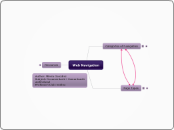Web Navigation
Categories of Navigation
Structural Navigation
Types
Main Navigation
Characteristics
Provides an overview and answers important questions
Aids in orientation
It allows people to switch topic
Reminds visitors where they are in a site
It gives shape to a site: in many ways it defines the boundaries of the site itself
Local Navigation
Characteristics
Transitions from page to page with a local navigation are smooth and consisten
It provides a great deal of context
It supports general exploration
It also points to content a visitor might not have known existed
Format types
Inverted L
Horizontal
Embeddedvertical
Associative Navigation
While reading about one topic, the user can access to other topics
Common types
Contextual Navigation
Characteristics
It is generally placed close to the content of a page
It creates a strong connection between the meaning of a text and the linked related pages
Types
Embedded Navigation
Related links
Adaptative Navigation
Quick links
Footer Navigation
Characteristics
Generally located at the bottom of the page
It is usually represented by text links
It commonly contains supplementary information not pertinent to main topic of the site
Pros & Cons
It doesn’t intrude on site content or functionality, potentially saving valuable real estate
scrolling longer pages becomes less problematic
Links in a footer area may not be as visible as navigation elsewhere on the page
Utility Navigation
Characteristics
They are generally not part of the main topic hierarchy of the site.
It may lead to varying page types or site functions
It is generally smaller than primary navigation mechanisms
It can appear as simple text links on the top, sides, or bottom of the page and often related to main navigation
Types
Extra-site navigation
Toolboxes
Linked logos
Language and conuntry selectors
Same content for different counties
In a multilanguage website this tool allows people to switch between different languages. 
Different content for each country
A country selector allows visitors to pick their market region.
Internal page navigation
Pros
When web pages are very long it may be advantageous to add internal page links that allow people to jump from one section of a page to another.
Couns
People may expect a transition to a new page when clicking a link, but instead, they are simply moved down on the same page.
Internal links may or may not be shown as visited links, depending on the link construction and browser.
if the last section of content is short, an internal link to it at the top may not scroll to the proper position: it may be shown at the top of screen.
Page Types
Navigational Pages
Key navigational pages
Home Page
They direct visitors to key areas of the web page
They contain text content or functionality but in abbreviated format only
It is often viewed as a chance to market products or promote a brand image
Landing Pages
They provide an outline to the content in a given section
They must provide both local and global orientation
Gallery Pages
They provide an overview of a specific group of products or content
They contain critical shopping information and allow visitors to compare products
Search Result Pages
They are similar to Gallery Pages
They are dynamically created based on user-entered keywords
Content Pages
The focus should be the content
There might not be too many graphics or images
On information-rich web sites there could be a Product Page
Typical elements
Product pictures
Product descriptions
Further details
Related products
They often contain several functional elements
Add to shopping cart or purchase
Save to a wish list
View larger images or zoom in
Change size or color
Email this page
Functional Pages
Characteristics
They are often the destination page tat fulfills a user need
There may be little or no text on such pages
They often lack embedded navigation and related links
Users need to focus on completing the task at hand, but linking to another page while filling out a form or finishing a process may result in loss of input
Function Types
Search Forms
This offers more control tha a simple search
It usualy requires more space; consequently, a separate page is usually needed
There might be links to
Search tips
Help
Other explanations
Hide options
Types
Scoping options
Word wheels
Submission Forms
As with search pages, associative navigation on forms is discouraged
Such forms require explicit action to save data
Web Applications
As web technologies become more robust, online applications will become more common
More advanced types of applications are becoming more common, mirroring desktop programs
Generally the functions to manipulate the datasheet at the top closely resemble software navigation
Resources
Designing web navigation by James Kalbach
